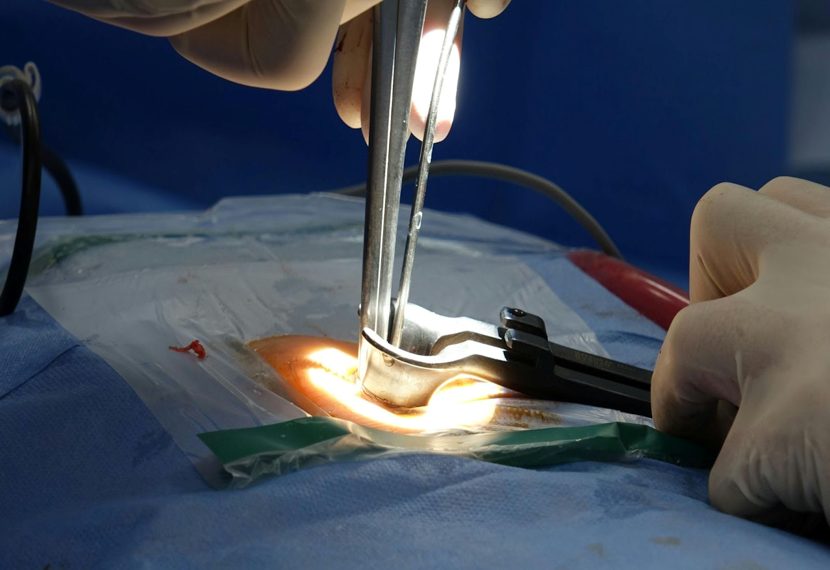
@ShahidNShah


Tampa specialists excel in diagnosing and treating herniated discs through a meticulous process grounded in clinical expertise. They utilize thorough medical histories, physical examinations, and cutting-edge imaging techniques like MRI to precisely assess disc pathology. By crafting personalized treatment plans incorporating non-surgical interventions such as physical therapy and acupuncture, they address individual patient needs. Their approach, focusing on symptom alleviation and spinal stability, invites further exploration into their effective methodologies.
A herniated disc, also known as a slipped or ruptured disc, occurs when the nucleus pulposus—a gel-like center—protrudes through a tear in the annulus fibrosus, the outer ring of an intervertebral disc. Herniated disc symptoms include localized pain, radiculopathy, and neurological deficits depending on the affected nerve root. Patients often report radiating pain, numbness, or weakness in the extremities. Common causes include age-related degenerative changes, traumatic injury, or repetitive strain, which compromise disc integrity. Occupational hazards involving heavy lifting or prolonged sitting may exacerbate these conditions. Clinicians often observe that individuals with a sedentary lifestyle or poor posture are at increased risk. Understanding these factors is essential for targeted intervention and effective management of herniated disc presentations.
Diagnosing herniated discs with precision demands the utilization of advanced imaging modalities. Magnetic Resonance Imaging (MRI) serves as the cornerstone for evaluating intervertebral disc pathologies, offering unparalleled soft tissue contrast and spatial resolution. This advanced imaging technique enhances diagnostic accuracy by delineating the extent of disc herniation and its effect on adjacent neural structures. Computed Tomography (CT), often employed in conjunction with myelography, provides detailed bony architecture visualization, essential in pre-surgical planning. Specialists in Tampa employ these modalities to determine the precise anatomical location, severity, and implications of herniations. Through advanced imaging, clinicians achieve a thorough understanding of the spinal anatomy, facilitating tailored therapeutic strategies. Therefore, the integration of cutting-edge imaging is paramount in the accurate diagnosis of herniated discs.
Thorough initial patient assessment is essential for formulating an effective treatment plan for suspected herniated discs. During the initial consultation, specialists gather extensive medical histories, focusing on symptomology such as pain location, intensity, and duration. Clinical experience dictates that understanding the patient’s occupational and lifestyle factors further aids in diagnosis. A meticulous physical examination follows, employing specific maneuvers to elicit pain responses and assess neurological deficits. Techniques such as the straight leg raise test evaluate nerve root irritation, while sensory and reflex assessments identify potential nerve compression. These detailed evaluations provide vital insights, guiding subsequent diagnostic imaging decisions. By integrating initial consultation findings with targeted physical examination results, specialists in Tampa develop an accurate clinical picture of the herniated disc’s impact.
With a thorough understanding of the patient’s condition established through initial assessments, specialists proceed to formulate personalized treatment plans for herniated discs. These plans incorporate clinical insights and are tailored to address the unique anatomical and symptomatic presentations of each patient. Utilizing a multidisciplinary approach, specialists integrate holistic therapies such as acupuncture and chiropractic care, fostering an all-encompassing treatment model. Patient engagement is imperative; specialists actively involve patients in decision-making processes, ensuring adherence and optimizing therapeutic outcomes. Personalized plans may involve physical therapy regimens, nutritional guidance, and lifestyle modifications. This individualized approach not only targets symptom alleviation but also aims to improve overall spinal health, thereby enhancing functional capacity and quality of life. Precision in treatment execution is fundamental to successful patient outcomes.
Non-surgical interventions for pain relief in cases of herniated discs focus on mitigating discomfort and enhancing mobility without the need for invasive procedures. Acupuncture therapy, an ancient technique rooted in traditional Chinese medicine, is utilized to stimulate specific points on the body, aiming to alleviate pain by promoting endorphin release and enhancing blood flow. Concurrently, chiropractic adjustments employ manual manipulation to correct spinal alignment, potentially reducing nerve compression and improving functional outcomes. These interventions are tailored to the patient’s specific presentation, with clinical evidence supporting their effectiveness in reducing pain and improving quality of life. By integrating these modalities, specialists in Tampa offer a thorough approach that prioritizes non-invasive management, minimizing the risks associated with surgical interventions for herniated disc patients.
In cases where conservative treatments fail to provide adequate relief, advanced surgical options become imperative for addressing severe herniated discs. Specialists in Tampa employ cutting-edge techniques such as minimally invasive procedures and robotic assisted surgeries to enhance precision and outcomes. Minimally invasive techniques involve smaller incisions, reducing tissue trauma and promoting faster recovery. These procedures often include microdiscectomy, which removes disc fragments through a small portal. Robotic assisted surgeries provide enhanced visualization and dexterity, allowing surgeons to execute complex maneuvers with increased accuracy. This technological advancement minimizes surgical risks and optimizes patient outcomes. Such surgeries are typically indicated for patients with significant neurological deficits or intractable pain, ensuring effective disc decompression and stabilization while preserving surrounding anatomical structures.
Following advanced surgical interventions, the focus shifts to thorough rehabilitation and physical therapy strategies to facilitate ideal recovery. Rehabilitation techniques are meticulously tailored to each patient’s unique presentation, emphasizing gradual restoration of function and prevention of recurrence. Initial assessments by physical therapists identify specific impairments, guiding the selection of appropriate physical therapy modalities. Core stabilization exercises, neuromuscular re-education, and proprioceptive training are integral components, designed to enhance spinal support and biomechanical efficiency. Manual therapy techniques, such as joint mobilizations and soft tissue manipulation, are employed to alleviate residual pain and improve mobility. Additionally, progressive resistance training and cardiovascular conditioning are incorporated to restore endurance and strength. These extensive strategies guarantee a structured, evidence-based approach to optimize post-operative outcomes.
How does patient education fundamentally contribute to the management of herniated discs? Patient education serves as a cornerstone in clinical management by enhancing patient empowerment. Through thorough educational initiatives, patients gain a clearer understanding of their condition, prognosis, and the importance of adherence to prescribed therapeutic regimens. Tampa specialists emphasize that informed patients are more likely to engage in self care strategies that mitigate symptoms and prevent exacerbation. These strategies often include ergonomic adjustments, tailored exercise regimens, and lifestyle modifications, all of which are pivotal in managing pain and improving functional outcomes. By fostering a collaborative environment, healthcare providers enable patients to assume an active role in their treatment, ultimately leading to more effective management of herniated disc-related challenges.
In the context of long-term management of herniated discs, lifestyle modifications play a critical role in mitigating recurrence risk. Implementing targeted strengthening exercises is essential, as they enhance spinal stability and reduce biomechanical strain on intervertebral discs. Specialists providing herniated disc treatment in Tampa should emphasize the integration of these strategies into patient care plans to optimize outcomes and prevent future complications.
Frequently, lifestyle modifications play an essential role in the long-term management and prevention of recurrent herniated discs. Clinical evidence suggests that dietary changes, aimed at reducing inflammation and promoting overall spinal health, are fundamental. A balanced diet rich in omega-3 fatty acids, antioxidants, and essential nutrients supports disc integrity and may reduce the risk of further disc herniation. Additionally, ergonomic adjustments in daily activities are critical. Ensuring proper posture and alignment during sitting, standing, and lifting can alleviate undue spinal stress. Utilizing ergonomic furniture and tools at work and home aids in maintaining ideal spinal alignment. Clinicians underscore the importance of these modifications as part of a thorough treatment plan, emphasizing their role in minimizing recurrence and enhancing patient outcomes.
While dietary adjustments and ergonomic practices are essential for managing herniated discs, the incorporation of targeted strengthening exercises provides substantial benefits in long-term management and prevention of recurrence. Enhancing core stability is pivotal, as it directly supports the spine, reducing undue stress on intervertebral discs. Clinicians emphasize the importance of engaging in flexibility training, which aids in preserving and improving the range of motion, thereby mitigating stiffness and facilitating adaptive responses to physical stressors. Implementing a regimen that integrates both core stability and flexibility training can fortify spinal mechanics, potentially decreasing the incidence of disc herniation. Through clinical experience, specialists recognize that these exercises not only alleviate current symptoms but also establish a proactive approach to spinal health maintenance.
The rehabilitation timeline for herniated disc treatment varies, typically ranging from weeks to months. Recovery strategies include physical therapy, pain management, and lifestyle modifications. Clinical experience indicates that patient adherence greatly influences recovery duration and overall outcomes.
Dietary recommendations for herniated disc patients often include consuming nutrient-rich foods and adopting an anti-inflammatory diet. This approach may help reduce inflammation and support recovery, leveraging clinical expertise and knowledge of precise nutritional interventions.
Exploring alternative therapies for herniated disc management, one may consider acupuncture, which offers benefits in pain relief through meridian stimulation. Additionally, chiropractic adjustments can aid in realigning spinal structures, potentially reducing pressure on affected nerves.
Stress can exacerbate herniated disc symptoms by increasing muscle tension and inflammation. Effective stress management and attention to emotional health are essential to minimizing symptom severity and improving overall patient outcomes in clinical settings.
Weather patterns, particularly changes in barometric pressure and humidity, can influence pain fluctuations in individuals with herniated discs. Clinical experience indicates these fluctuations may exacerbate discomfort, affecting daily activities and overall quality of life.

In the evolving landscape of spine health treatment, NeuroSpine Plus stands at the forefront of innovation, revolutionizing how spine conditions are diagnosed, treated, and managed. With an unwavering …
Posted May 26, 2025 Health Technology Patient Experience
Connecting innovation decision makers to authoritative information, institutions, people and insights.
Medigy accurately delivers healthcare and technology information, news and insight from around the world.
Medigy surfaces the world's best crowdsourced health tech offerings with social interactions and peer reviews.
© 2025 Netspective Foundation, Inc. All Rights Reserved.
Built on Dec 10, 2025 at 1:15pm